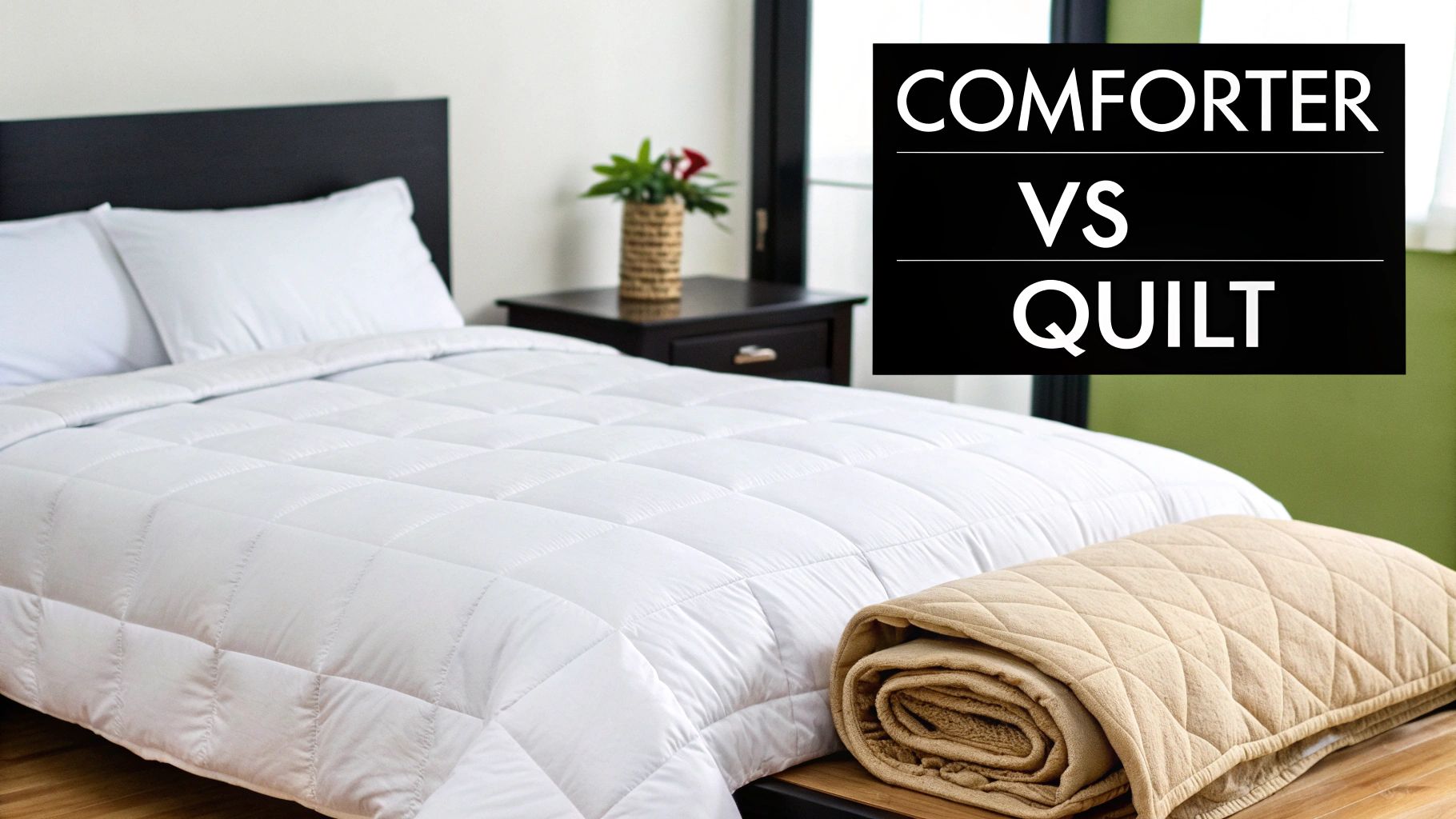Struggling to choose between a comforter and a quilt? You're not alone. Picking the right bed topping can feel like a major decision, but it's simpler than you think. The comforter vs quilt debate really boils down to one question: do you prefer a single, cloud-like layer of warmth, or a lighter, more adaptable covering? A comforter is your plush, all-in-one solution for cosy nights, while a quilt offers a thinner, textured option perfect for layering.
This guide cuts through the confusion, helping you find the perfect match for your sleep style and bedroom aesthetic.

Comforter vs Quilt: The Main Differences
It's easy to get lost in bedding terms, especially with words like 'duvet' and 'doona' in the mix. To keep it simple, let's focus on the key distinctions. A comforter is a single, puffy blanket built for warmth. A quilt is a thinner, three-layer covering known for its detailed stitching. If you're curious about those other terms, our quilt vs duvet guide explains everything.
Choosing the right bedding is more than just a style choice; it's an investment in your sleep quality. To help you see the differences clearly, here's a quick comparison.
At a Glance: Comforter vs Quilt
This table breaks down the core features to give you a straightforward snapshot.
| Feature | Comforter | Quilt |
|---|---|---|
| Warmth & Loft | High loft, very warm, and fluffy | Low loft, moderately warm, and dense |
| Construction | A single piece filled with down or synthetic fibres, stitched to keep fill in place | Three layers (top, batting, back) held together with decorative stitching |
| Best For | Cold sleepers, winter months, and those who prefer a single plush layer | Hot sleepers, summer months, or layering for year-round use |
| Aesthetic | Modern, simple, and cloud-like | Traditional, textured, and often decorative |
| Maintenance | Often requires professional cleaning or large-capacity machines | Typically machine-washable and easier to care for at home |
What is a Comforter?
Think of a comforter as a single, soft, and puffy blanket designed to be the only layer you need for a warm and simple bed. In the great ‘comforter vs quilt’ debate, the comforter is the undisputed champion of plush, all-in-one cosiness. It's essentially a fabric shell stuffed with an insulating material, like down or a synthetic alternative, to create that signature cloud-like feel.

The construction is simple. Unlike the intricate, tight stitching on a quilt, a comforter is stitched through just enough to prevent the fill from bunching up. This minimal quilting allows the filling to fluff up, creating a lofty, uniform look that suits a clean, modern bedroom aesthetic perfectly.
Construction and Fill Materials
Every comforter consists of an outer shell and an inner fill. The shell is usually made from cotton or polyester, but the filling is what determines its warmth and feel.
- Natural Fill: Materials like goose or duck down provide incredible warmth without the weight. A high fill power means more warmth with less bulk, making it feel light and airy.
- Synthetic Fill: Hypoallergenic options like polyester or microfibre are great for those with allergies. They mimic the softness of down and are generally easier to wash and maintain.
Real-world example: Someone in Tasmania during winter would find a high-loft goose-down comforter ideal. It traps body heat efficiently while feeling almost weightless.
Care and Maintenance Considerations
Comforters can be tricky to clean due to their size. Their sheer bulk, combined with delicate fills like natural down, often means they need a trip to a laundromat for a commercial-sized machine or professional dry cleaning to stay in top shape.
To ensure your comforter remains fluffy, follow care instructions carefully. For a detailed walkthrough, see our guide on how to wash doonas and comforters correctly.
What is a Quilt?
When you dive into the classic comforter vs quilt debate, you quickly realise a quilt is much more than just a simple bed covering. Unlike the single-layer design of a comforter, a quilt is a masterclass in layered construction, celebrated for its unique craftsmanship and rich texture.
Traditionally, every quilt is built from three distinct parts, all stitched together to create a single, cohesive piece.
This layered anatomy gives a quilt its signature feel. Because the layers are stitched so tightly together, quilts end up being thinner and denser than their puffy comforter cousins. The result is a gentle, comforting weight rather than overwhelming, fluffy insulation.
The Three Core Layers
A quilt's structure is brilliantly simple. It’s the way these three layers come together that defines its style and function.
- The Top Layer: This is the quilt's decorative "face." It’s what you see first, often showcasing intricate patchwork, appliqué designs, or simply a single piece of beautifully printed fabric.
- The Batting: Sandwiched in the middle, this thin layer is the quilt's engine room for warmth. Usually made from cotton, wool, or polyester, its thickness determines its insulation level.
- The Backing: The bottom layer is typically a solid piece of fabric, chosen to feel smooth and comfortable against your skin.
The stitching is what truly sets a quilt apart. This quilting process binds all three layers, creating intricate patterns that add texture, strength, and a handcrafted aesthetic.
Versatility and Practical Use
This clever construction makes quilts incredibly versatile. Imagine a lightweight cotton quilt on a bed in warm Brisbane—it's breathable enough to be the only cover you need on a summer night. Come winter, that same quilt can be draped over a doona for an extra layer of cosy insulation.
Its weight, often measured in GSM (Grams per Square Metre), is a huge part of its versatility. You can learn more about this in our guide on what is GSM in quilts. This adaptability is why layered bedding is so popular.
Key Comparison: Comforter vs Quilt
Now that you know the basics, let’s compare the practical side of the comforter vs quilt decision. How you sleep, your cleaning routine, and your bedroom's style will guide you to the right choice.
Warmth and Weight
A comforter delivers plush, enveloping warmth. It traps air with insulating materials like down or synthetic fibres, creating a cosy barrier perfect for cold sleepers or chilly winters. A high-loft down comforter provides incredible warmth but feels surprisingly light.
A quilt, on the other hand, gets its warmth from density, not fluff. The layers are stitched tightly, compressing the internal batting (usually cotton or wool) for a thinner but heavier feel. This makes it an excellent choice for hot sleepers who want gentle, breathable warmth.
Real-world scenario: A couple in Melbourne during a frosty winter would love a high-loft down comforter. Meanwhile, a family in sunny Perth would likely find a breathable cotton quilt far more comfortable for most of the year.
Cleaning and Durability
Maintenance is a huge factor. Quilts are usually the winner for easy care, as most can be tossed into a home washing machine. Their tough stitching and sturdy materials are built to handle regular washing, making them a practical pick for kids' rooms or guest beds.
Comforters, especially those filled with natural down, can be more high-maintenance. Their bulk is often too much for a standard washing machine, and improper washing can ruin the fill. Many need professional cleaning, adding to the cost and hassle. Choosing between down vs alternative down fills is a key step, as it affects both comfort and care.
Style and Aesthetics
Comforters and quilts bring very different vibes to a bedroom.
- Comforters: These offer a smooth, plush, and uniform look. Often found in solid colours or simple patterns, they are perfect for a minimalist, modern, or clean hotel-like aesthetic.
- Quilts: Quilts are all about adding texture and pattern. The intricate stitching and patchwork designs can become a decorative centrepiece, ideal for traditional, bohemian, or cosy farmhouse styles.
An interior designer aiming for a crisp, luxury hotel feel would likely choose a white comforter. Someone wanting to add personality and handcrafted charm would use a vibrant quilt as a focal point.
Which is Best for Your Lifestyle and Climate?
In the comforter vs quilt debate, the right answer depends on you—your local climate, how you sleep, and your daily routine. Think of it as matching your bedding to your environment.
For the Hot Sleeper or Warm Climate
If you often kick the covers off or live where nights are warm, a quilt is your best friend. Quilts are more breathable, especially when made from natural fibres like cotton or bamboo. This allows air to circulate and wicks away moisture, preventing that stuffy feeling.
For those who struggle with overheating, a specialty cooling quilt can make a huge difference. You can learn how a cooling quilt works in our detailed guide.
Sleep Fact: Research shows the ideal temperature for restorative sleep is a cool 18.3°C. A breathable quilt helps you stay in that zone by letting excess body heat escape, making it a clear winner for hot sleepers.
For the Cold Sleeper or Cool Climate
If you're always feeling a chill or live somewhere with cold winters, a comforter is the champion. Its fluffy, high-loft design is built to trap your body heat, creating an insulating cocoon of warm air. A quality down or down-alternative comforter provides incredible warmth without feeling heavy.
This simple decision tree breaks it down based on whether you run hot or cold.

As you can see, your body's thermostat is the best guide for choosing your bedding.
For Families and Practicality
In a busy household with kids or pets, a quilt's practicality often wins. Its sturdy construction holds up to repeated washing much better than a delicate comforter. Spills and muddy paws are less of a headache when you can simply toss the quilt in your washing machine.
Understanding different blanket material options like fleece, sherpa, and woven fabrics also helps, as the material directly impacts both feel and function.
Making Your Final Decision
You’ve seen how comforters and quilts stack up. Now it’s time to pick the one that’s right for you. The perfect bedding does more than keep you warm; it turns your bedroom into a personal sanctuary.
- Choose a comforter if: Your top priority is sinking into a plush, cloud-like cocoon of warmth. It's the ideal all-in-one solution for cold sleepers or anyone who loves the simplicity of a single, lofty layer.
- Choose a quilt if: You’re looking for versatility, a stylish layered look, and bedding that's easy to care for. They’re fantastic for hot sleepers, warmer climates, or anyone who enjoys mixing and matching textures.
Don't forget to consider your room's overall vibe. A sleek comforter suits a minimalist or modern setup. A quilt, with its rich texture, can be the standout piece in a traditional or bohemian room. You can find more tips on how to choose bedroom furniture to create a cohesive space.
Frequently Asked Questions
Still deciding between a comforter and a quilt? Let’s clear up some common questions so you can choose with confidence.
Can I Use a Quilt and a Comforter Together?
Absolutely! Layering a quilt over a comforter is a popular way to style your bed, especially in winter. It adds extra warmth and brings a lovely, textured look to the room. Drape a beautiful quilt across the foot of the bed over your fluffy comforter for a pop of colour and an extra cosy layer when you need it.
What Is a Doona and How Does It Compare?
In Australia, 'doona' is our local term for a duvet or duvet insert. A doona is designed to be placed inside a removable, washable cover. While a doona is a type of comforter, its key difference is that it requires a cover, whereas some comforters are a single, decorative piece. We explain this further in our quilt vs duvet guide.
Which Bedding Is Better for Allergies?
Neither is automatically better; it all comes down to the materials. For allergy sufferers, look for comforters with hypoallergenic fills like microfibre or quilts made from natural, breathable fibres like cotton or bamboo. The best option is always bedding that can be washed frequently in hot water to eliminate dust mites, so check the care label before you buy.
Find Your Perfect Bedding Today
The right bedding is the foundation of a great night's sleep. Whether you're drawn to the luxurious warmth of our feather and down comforters or the versatile charm of our bamboo quilts, the perfect choice is waiting for you.
Ready to create your dream bed? Explore the full collection at Sienna Living and find the perfect piece to complete your sleep sanctuary. Visit us at https://www.siennaliving.com.au.

